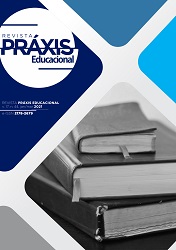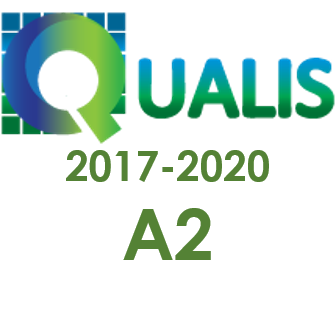FRAYED RURALITIES AND CHILDREN'S WAYS OF WRITING THE SCHOOL
DOI:
https://doi.org/10.22481/praxisedu.v17i44.8019Keywords:
Ruralities, Children's narratives, Rural school, Elementary SchoolAbstract
The text results from an investigation carried out in a rural community in the backlands of Bahia. To this end, it moved from the following question: what do the children tell about the experience of inhabiting Old Canudos? Throughout the study we seek to understand how children weave their experiences, assign meanings to places and graph spaces lived. From the methodological point of view, the study was based on assumptions of (auto)biographical research, in the narrative research aspect, using oral narratives from three students of the Early Years of Elementary School and observations. The research revealed that, in the investigated context, the experience of living in rural areas is marked by processes of social exclusion and marginalization, associated with the denial of rights and the absence of public policies that ensure better living conditions for the subjects. This scenario, which shows the thinning of the rural, presents emblematic elements to think about the role of the state and policies that act to transform this reality, specifically in relation to school / education.
Downloads
Metrics
References
ARIÉS, Philippe. História social da criança e da família. 2ª ed., Rio de Janeiro: Guanabara: 1973.
ARROYO, Miguel Gonzalez. Ofício de mestre: imagens e auto-imagens. 13 ed., Petrópolis-RJ: Ed. Vozes, 2011.
BARROS, Manoel de. Poesia completa. São Paulo: Leya, 2010.
BARROS, Manoel. de. Memórias Inventadas para as crianças: A Segunda Infância. São Paulo: Planeta do Brasil, 2006.
BENJAMIN, Walter. O Narrador. In: Benjamin, W. Magia e Técnica, Arte e Política - ensaios sobre literatura e história da cultura (197-221). Tradução de Sergio Paulo Rouanet. Obras escolhidas, volume I, 4ª edição, São Paulo: Editora Brasiliense, 2000.
BRASIL. Ministério da Educação. Diretrizes Operacionais para a Educação Básica nas Escolas do Campo. Resolução CNE/CEB 1, 2002.
CERISARA, Ana Beatriz. Em busca do ponto de vista das crianças nas pesquisas educacionais: primeiras aproximações. In SARMENTO, Manuel Jacinto. CERISARA, Ana Beatriz. Crianças e miúdos: perspectivas sociopedagógicas da infância e educação. Lisboa: Asa editores, 2004, p. 35-54.
CERTAU, Michel de. A invenção do cotidiano 1: Artes de fazer. Tradução de Ephraim Ferreira Alves. Petrópolis: Vozes, 1994.
CORSARO, William.A. Sociologia da infância. 2. Ed. Porto Alegre: Artmed, 2011.
DELORY-MOMBERGER, C. Abordagens metodológicas na pesquisa biográfica. Tradução de Anne-Marie Milon Oliveira. Revista Brasileira de Educação, 17(51), 523-536, 2012. http://www.scielo.br/pdf/rbedu/v17n51/02.pdf
FERNANDES, B.M. Diretrizes de uma caminhada. In: ARROYO, M.G; CALDART, R.S.; MOLINA, M.C. Por uma educação do campo. Petrópolis: Vozes, 2004. p. 133- 145.
GENTILI, Pablo; MC COWAN, Tristan (Org.). Reinventar a Escola Pública: política educacional para um novo Brasil. Petrópolis: Vozes, 2003. GONÇALVES. G.B.B. (2010). Nucleação das escolas rurais. In Oliveira, D.A.; DUARTE, A.M.C.; VIEIRA, L.M.F. Dicionário: trabalho, profissão e condição docente. Belo Horizonte: UFMG/Faculdade de Educação. http://gestrado.net.br/?pg=dicionario-verbetes
GOODSON, Ivor. Currículo, narrativa e o futuro social. Tradução: Eurize Caldas Pessanha e Marta Banducci Rahe. Revisão técnica: Elizabeth Macedo. Revista Brasileira de Educação. 12(35), 241-252, 200. http://www.scielo.br/pdf/rbedu/v12n35/a05v1235.pdf
GRAZIANO DA SILVA, J. O novo rural brasileiro. Campinas: Unicamp/Instituto de Economia, 1998.
HEIDEGGER, Martin. Ser e tempo – parte I. (trad. Marcia Sá C. Schuback) 12 ed. Petrópolis: Vozes, 2002.
INEP - Instituto Nacional de Estudos e Pesquisas Educacionais. Censo Escolar: resumos técnicos. Brasília: MEC/INEP, 2014. Disponível em: http://download.inep.gov.br/download/superior/censo/2014/resumo_tecnico_censo_educacao_superior_2014.pdf
PASSEGGI, Maria; NASCIMENTO, Gilcilene; OLIVEIRA, Roberta de. As narrativas autobiográficas como fonte e método de pesquisa qualitativa em Educação. Revista Lusófona de Educação, 33, 111-125, 2016. Disponível em: File:///C:/Users/Elizeu/Downloads/5682-Texto%20do%20artigo-17958-1-10-20161205.Pdf
SARMENTO, Manuel Jacinto & PINTO, Manuel. As crianças e a infância: Definindo conceitos, delimitando o campo. En PINTO, M. y SARMENTO, M. J. (orgs.): As crianças: Contextos e identidades. Braga: Centro de Estudos da Criança, Universidade do Minho, 1997, p. 9-30.
PINTO, M. & SARMENTO, M. J. (Org.). As crianças e a infância: definindo conceitos, delimitando campos. In: As crianças: contexto e identidades. Braga, Portugal: Centro de Estudos da Criança,
RICOEUR, Paul. Teoria da interpretação. Tradução de Artur Morão. Lisboa: Edições 70, 1976.
ROLNIK, Raquel. Guerra dos lugares: a colonização da terra e da moradia na era das finanças. São Paulo, Biotempo, 2015.
SANTOS, Milton. A Natureza do Espaço: Técnica e Tempo, Razão e Emoção. São Paulo: EdUSP, 1994.
SCHALLER, Jean Jacques.. (2008). Lugares aprendentes e a inteligência coletiva: rumo à constituição de um mundo comum. In PASSEGGI, M.C. e SOUZA, E.C. (Orgs.). (Auto)Biografia: formação, territórios e saberes. Natal, EDUFRN; São Paulo: Paulus, 2018, p. 67-84.
SILVA, Ana Paula Soares da; FELIPE, Eliana da Silva; RAMOS, Márcia Mara. Infâncias do Campo. In: CALDART, Roseli Salete [et al] (orgs). Dicionário da Educação do Campo. Rio de Janeiro Politécnica de Saúde Joaquim Venâncio; São Paulo: Escola, Expressão Popular, 2012, p. 417-424.
TUAN, Yi-Fu. Espaço e Lugar: a perspectiva da experiência. Tradução Lívia de Oliveira. São Paulo: DIFEL, 1983.
Downloads
Published
How to Cite
Issue
Section
License

This work is licensed under a Creative Commons Attribution-ShareAlike 4.0 International License.
You are free to:
Share - copy and redistribute the material in any medium or format; Adapt - remix, transform, and build from the material for any purpose, even commercially. This license is acceptable for Free Cultural Works. The licensor cannot revoke these freedoms as long as you follow the terms of the license.
Under the following terms:
Attribution - You must appropriately give credit, provide a link to the license, and indicate if any changes have been made. You may do so in any reasonable way, but not in a way that suggests that you or your use is endorsed by the licensor.
There are no additional restrictions - You cannot apply legal terms or technological measures that legally restrict others to make any use permitted by the license.










